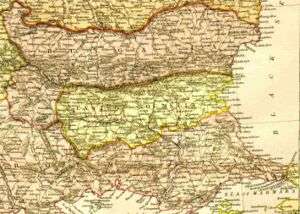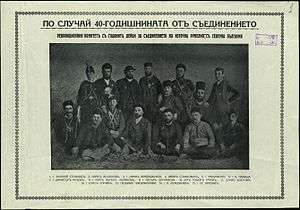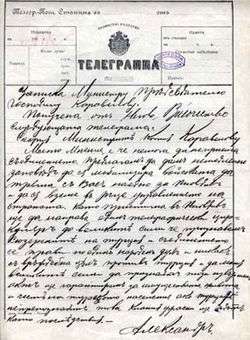Bulgarian unification
The Unification of Bulgaria (Bulgarian: Съединение на България, Saedinenie na Balgariya) was the act of unification of the Principality of Bulgaria and the province of Eastern Rumelia in the autumn of 1885.[1][2] It was co-ordinated by the Bulgarian Secret Central Revolutionary Committee (BSCRC). Both had been parts of the Ottoman Empire, but the Principality had functioned de facto independently whilst the Rumelian province was autonomous and had an Ottoman presence. The Unification was accomplished after revolts in Eastern Rumelian towns, followed by a coup on 18 September [O.S. 6 September] 1885 supported by the Bulgarian Knyaz Alexander I. The BSCRC, formed by Zahari Stoyanov, began actively popularizing the idea of unification by means of the press and public demonstrations in the spring of 1885.

Background
The 10th Russo-Turkish War (1877–1878) ended with the signing of the preliminary Treaty of San Stefano, which cut large territories off the Ottoman Empire. Bulgaria was resurrected after 482 years of foreign rule, albeit as an Principality under Ottoman suzerainty.
The Russian diplomats knew that Bulgaria would not remain within these borders for very long — the San Stefano peace was called "preliminary" by the Russians themselves. The Berlin Congress began on 13 June [O.S. 1 June] 1878 and ended on 13 July [O.S. 1 July] 1878 with the Berlin Treaty that created a vassal Bulgarian state in the lands between the Balkans and the Danube. The area between the Balkan Mountains and the Rila and Rhodope Mountains became an autonomous Ottoman province called Eastern Rumelia. The separation of southern Bulgaria into a different administrative region was a guarantee against the fears expressed by Great Britain and Austria-Hungary that Bulgaria would gain access to the Aegean Sea, which logically meant that Russia was getting closer to the Mediterranean.
The third large portion of San Stefano Bulgaria — Macedonia — did not get even this slight taste of liberty, as it remained in the Ottoman borders like it had been before the war.
Organization

In these conditions it was natural that Bulgarians in Bulgaria, Eastern Rumelia and Macedonia all strived for unity. The first attempt was made in 1880. The new British prime minister, William Ewart Gladstone (who had strongly supported the Bulgarian cause in the past) made Bulgarian politicians hope that the British policy on the Eastern Question was about to change, and that it will support and look favourably upon an eventual Union. Unfortunately, the change of government did not bring a change in Great Britain's interests. Secondly, there was a possible conflict growing between the Ottoman Empire on one side and Greece and Montenegro on the other.
The Union activists from Eastern Rumelia sent Stefan Panaretov, a lecturer in Robert College, to consult the British opinion on the planned Unification. Gladstone's government though, did not accept these plans. Disagreement came from Imperial Russia as well, which was strictly following the decisions taken during the Berlin Congress. Meanwhile, the tensions between Greece and the Ottoman Empire had settled, which finally brought the first Unification attempt to a failure.
By mid-1885 most of the active unionists in Eastern Rumelia shared the vision that the preparation of a revolution in Macedonia should be postponed and all efforts should be concentrated on the unification of Bulgaria and Eastern Rumelia. The Bulgarian Knyaz Alexander I was also drawn to this cause. His relations with Russia had worsened to such extent that the Russian Emperor and the pro-Russian circles in Bulgaria openly called for Alexander's abdication . The young knyaz saw that his support for the Unification is his only chance for political survival.
The act of Unification
The Unification was initially scheduled for the middle of September, while the Rumelian militia was mobilized for performing manoeuvres. The plan called for the Unification to be announced on 27 September [O.S. 15 September] 1885, but on 14 September [O.S. 2 September] 1885 a riot began in Panagyurishte (then in Eastern Rumelia) that was brought under control the same day by the police. The demonstration demanded Unification with Bulgaria. A little later this example was followed in the village of Goliamo Konare. An armed squad was formed there, under the leadership of Prodan Tishkov (mostly known as Chardafon) — the local leader of the BSCRC. BSCRC representatives were sent to different towns in the province, where they had to gather groups of rebels and send them to Plovdiv, the capital of Eastern Rumelia, where they were under the command of Major Danail Nikolaev.[3]

Meanwhile, military manoeuvres were being carried out in the outskirts of Plovdiv. Major Danail Nikolaev, who was in charge of the manoeuvres, was aware of and supported the unionists. On 18 September [O.S. 6 September] 1885, Rumelian militia (Eastern Rumelia's armed forces) and armed unionist groups entered Plovdiv and took over the Governor's residence. The Governor was Gavril Krastevich, a Bulgarian patriot who, naturally, did not resist the unionists.
A temporary government was formed immediately, with Georgi Stranski at its head. Major Danail Nikolaev was appointed commander of armed forces. With help from Russian officers, he created the strategical plan for defence against the expected Ottoman intervention. Mobilization was declared in Eastern Rumelia.
As soon as it took power on 14 September [O.S. 2 September] 1885, the temporary government sent a telegram, asking the knyaz to accept the Unification. On 20 September [O.S. 8 September] 1885 Alexander I answered with a special manifest. On the next day, accompanied by the prime minister Petko Karavelov and the head of Parliament Stefan Stambolov, Knyaz Alexander I entered the capital of the former Eastern Rumelia. This gesture confirmed the unionists' actions as a fait accompli. But the difficulties of the diplomatic and military defence of the Union lay ahead.
International response to the Unification
In the years after the signing of the Berlin Treaty, the St. Petersburg government had often expressed its view that the creation of Eastern Rumelia out of Southern Bulgaria was an unnatural division and would be short-lived. Russia knew that the Unification would undoubtedly come soon and took important measures for its preparation. First, Russia exerted successful diplomatic pressure upon the Ottoman Empire constraining it from sending forces into Eastern Rumelia. Also, in 1881, in a special protocol, created after the re-establishment of the League of the Three Emperors, it was noted that Austria-Hungary and Germany would show support for a possible union act of the Bulgarians.
Russia
Defying most expectations, Russia did not support the September 6 act due to its open conflict with Knyaz Alexander I. Russia wanted to preserve its influence in Bulgarian affairs and feared losing it as the new state grew stronger with Alexander I at its head. As a result, Russia commanded all its officers to leave Bulgaria and suggested that an official conference be held in Constantinople, where the violation of the Berlin status quo was to be sanctioned.
United Kingdom
The government circles in London initially thought that powerful support by St. Petersburg stood behind the bold Bulgarian act. They soon realised the reality of the situation, and after the Russian official position was announced, Great Britain gave its support for the Bulgarian cause, but not until Bulgarian-Ottoman negotiations began.[4]
Austria-Hungary
Austria-Hungary's position was determined by its policy towards Serbia. In a secret treaty from 1881, Austria-Hungary accepted Serbia's "right" to expand in the direction of Macedonia. Austria-Hungary's aim was to win influence in Serbia, while at the same time directing Serbian territorial appetites towards the south instead of north and north-west. Also, Austria-Hungary had always opposed the creation of a large Slavonic state in the Balkans of the sort that a unified Bulgaria would become.
France and Germany
They supported the Russian proposal of an international conference in the Ottoman capital.
Ottoman Empire
.jpg)
After the Unification was already a fact, it took three days for Constantinople to become aware of what had actually happened. A new problem then arose: according to the Berlin treaty the Sultan was only allowed to send troops to Eastern Rumelia at the request of Eastern Rumelia's governor. Gavril Krastevich, the governor at the time, made no such request. At the same time the Ottoman Empire was advised in harsh tone both by London and St. Petersburg not to take any such actions and instead to wait for the decision of the international conference. The Ottomans did not attack Bulgaria, neither intervened in the Serbo-Bulgarian War. On 5 April [O.S. 24 March] 1886 the Ottoman Empire and Bulgaria signed the Tophane Agreement, which recognized the Prince of Bulgaria as Governor-General of the autonomous Ottoman Province Eastern Rumelia. In this way, the de facto Unification of Bulgaria which had taken place on 18 September [O.S. 6 September] 1885, was de jure recognized.
Greece
The Union of Bulgaria and Eastern Rumelia made Bulgaria de facto the second-largest state in the Balkans at that time after Turkey in Europe, a fact that a number of neighbouring countries could not accept. Athens immediately asked for territorial compensations and even threatened it would begin military actions. There were civilian demonstrations throughout Greece that prompted the government to declare war on Bulgaria. However, Greece and Bulgaria did not have a common border at that time and were separated by Ottoman territory. Also, intervention on the part of the British government helped soothe this agitation.
Serbia
Serbia's position was similar to that of Greece. The Serbians asked for considerable territorial compensations along the whole western border with Bulgaria. Rebuffed by Bulgaria, but assured of support from Austria-Hungary, king Milan I declared war on Bulgaria on 14 November [O.S. 2 November] 1885. However, after the decisive Battle of Slivnitsa, the Serbs suffered a quick defeat and the Bulgarians advanced into Serbian territory up to Pirot. Austria-Hungary demanded the ceasing of military actions, threatening that otherwise the Bulgarian forces would meet Austro-Hungarian troops. The ceasefire was signed on 28 November 1885. On 3 March 1886, the peace treaty was signed in Bucharest. According to its terms, no changes were made along the Bulgarian-Serbian border, preserving the Unification of Bulgaria.
Honours
- The Unification Day is celebrated on 6 September as a national holiday in Bulgaria.
- The town of Saedinenie in Plovdiv Province, Bulgaria, bears the name of the Unification of Bulgaria.
- Saedinenie Snowfield on Livingston Island in the South Shetland Islands, Antarctica is named for the Unification of Bulgaria.[5]
Notes
- Chisholm, Hugh, ed. (1911). . Encyclopædia Britannica (11th ed.). Cambridge University Press.
- Anderson, Frank Maloy; Hershey, Amos Shartle (1918). "The Bulgarian Revolution of 1885". Handbook for the Diplomatic History of Europe, Asia, and Africa 1870-1914. Washington, DC: National Board for Historical Service, Government Printing Office. pp. 119–122. Retrieved 2 February 2013.
- Miller, William (1896). "The Union Under Prince Alexander". The Balkans: Rumania, Bulgaria, Servia, Montenegro (Story of the Nations). New York: G. P. Putnam's Sons. p. 223. Retrieved 2 February 2013.
- Monroe, Will. S. (1914). Bulgaria and Her People, with an Account of the Balkan Wars, Macedonia, Macedonian Bulgars. Boston: The Page Company. p. 55. Retrieved 2 February 2013.
- "Saedinenie Snowfield", SCAR Composite Gazetteer of Antarctica, retrieved 6 September 2018
References
- Schuyler, Eugene (November 1885), "United Bulgaria", The North American Review, 141, University of Northern Iowa, pp. 464–474, JSTOR 25118547.
- Laveleye, Emile de (November 1886). "The Situation in the East". The Contemporary Review. L: 609–619. Retrieved 25 September 2018 – via Internet Archive.
- Lang, Robert Hamilton (1886). Roumelian Coup D'état, Servo-Bulgarian war, and the latest phase of the Eastern question. London: Harrison and Sons. Retrieved 6 September 2018 – via Internet Archive.
- Samuelson, James (1888). Bulgaria: Past and Present, Historical, Political and Descriptive. London: Trübner and Co. pp. 79-83. Retrieved 6 September 2018 – via Internet Archive.
- Holland, Thomas Erskine (1898), "Bulgaria, Greece and the Treaty of Berlin", Studies in International Law, Oxford: Clarendon Press, pp. 251–269, retrieved 23 September 2018 – via Internet Archive
- Gilman, Daniel Coit; Peck, Harry Thurston; Colby, Frank Moore, eds. (1903). "Bulgaria". The New International Encyclopaedia. III. New York: Dodd, Mead and Company. p. 592. Retrieved September 6, 2018 – via HathiTrust Digital Library.
- J. D. B. (1910). "Bulgaria (Union with Eastern Rumelia)". The Encyclopaedia Britannica; A Dictionary of Arts, Sciences, Literature and General Information. IV (BISHARIN to CALGARY) (11th ed.). Cambridge, England: At the University Press. pp. 782–783. Retrieved 6 September 2018 – via Internet Archive.
- Rose, J. Holland (1922). "The Making of Bulgaria". The Development of the European Nations; 1870-1921 (6th ed.). New York and London: G.P. Putnam's Sons. pp. 299–343. Retrieved 24 September 2018 – via Internet Archive.
- Hyde, Arthur May (1931). "Union of the Two Bulgarias". A Diplomatic History of Bulgaria, 1870-1886. Urbana: University of Illinois. pp. 141–158. Retrieved September 6, 2018 – via HathiTrust Digital Library.
- Jono Mitev — "The Unification" / Йоно Митев — "Съединението", Военно издателство